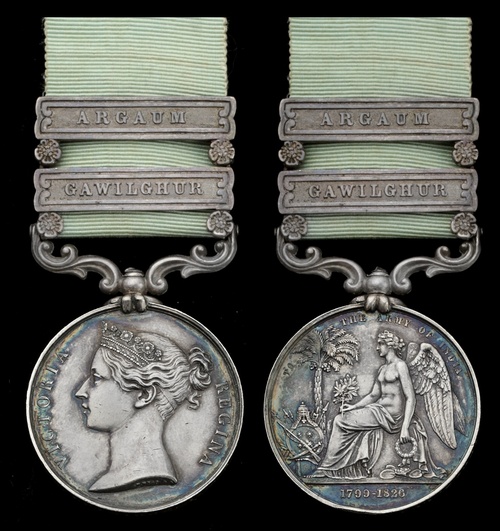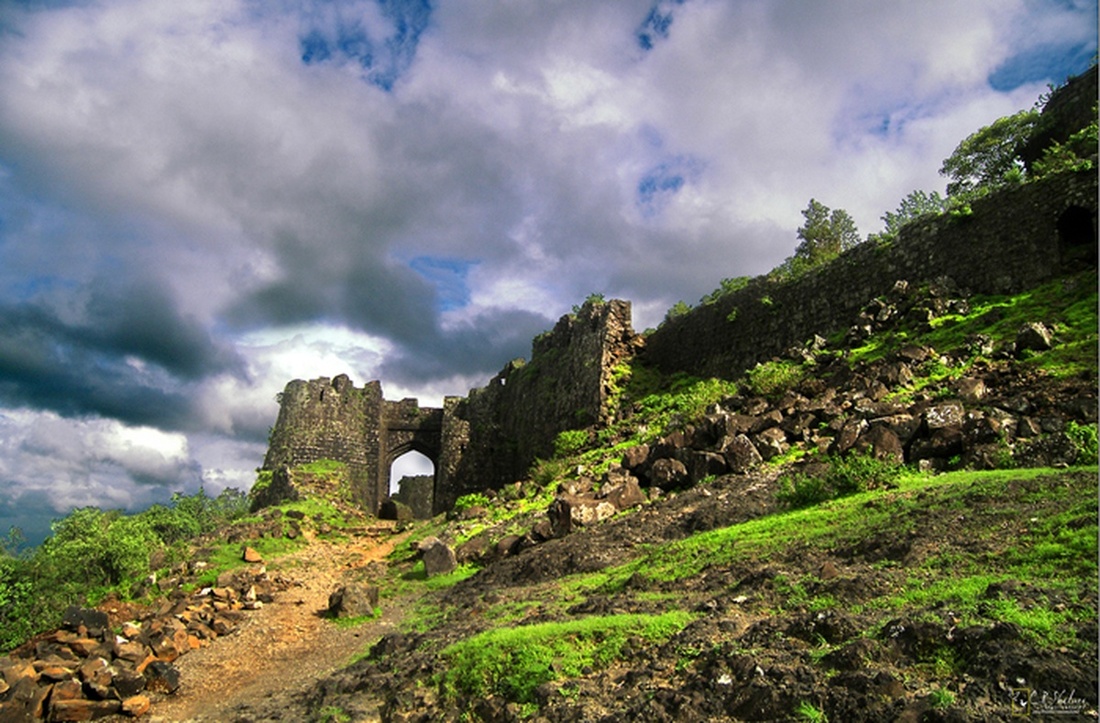Auction: 22003 - Orders, Decorations and Medals
Lot: 13
(x) The early and rare Army of India Medal awarded to the splendidly-named Major Skeffington Lutwidge, 11th Madras Native Infantry, who participated in the Battle of Argaum and Siege of Gawilghur and whose Medal and Clasps represent a unique entitlement to the Regiment
Army of India 1799-1826, short-hyphen reverse, 2 clasps, Gawilghur, Argaum (Lieut S. Lutwidge, 11th N.I.), one minor edge knock and a few small scratches, otherwise good very fine
Skeffington Lutwidge, second son of Henry Lutwidge of Holmrook Hall in Cumbria, was born on 23 May 1779 and after a period of study at St. John's College Cambridge entered the service of the Honourable East India Company's forces as a Cadet, in 1797. Appointed to the 11th Madras Native Infantry, he was promoted Second Lieutenant in August of 1798 and Lieutenant four months later. It was in this rank that he participated in the Second Anglo-Maratha War (1803-05), notable for exposing the talent and exceptional generalship of a young Arthur Wellesley - the man who was to later become Field Marshal the Duke of Wellington, victor of Waterloo.
Both 1st and 2nd battalions of the M.N.I. were part of the force commanded by Colonel James Stevenson of the East India Company - not as imaginative and dynamic an officer as Wellesley, but a reliable and steady individual and one of few the latter trusted implicitly. At Argaum (29 November 1803) Wellesley's and Stevenson's separate commands united to face the armies of Raghoji II Bhonsle and Daulat Rao Scindia: the British and E.I.C. forces were massively outnumbered (approximately 11,000 versus 40,000) but had a far superior fighting spirit to the Mahrathas. With both battalions of the 11th M.N.I. on the left flank of the army, the whole line advanced towards their enemy: the 2/11th repulsed a half-hearted charge by Maratha cavalry, and along with the rest of Wellesley's combined army continued a steady advance, negotiating uneven ground, ditches and dry nullah's along the way. Coming into effective musketry range of enemy infantry, the British & E.I.C. line opened fire and very quickly their foe began to melt away: this was followed-up by a cavalry charge which quickly turned the battle into a rout. Wellesley and Stevenson (who, on account of illness due to fever, directed his command from a howdah atop an elephant) had won an impressive victory at very little cost.
From Argaum Wellesley's small army advanced towards the fortress of Gawlighur, a well-fortified mountain stronghold north of the Deccan plateau. Though from a distance the fortifications looked impressive, they were somewhat antiquated by the standards of the day and vulnerable to bombardment by artillery. Wellesley and Stevenson separated, the plan being that the former would attack from the south whilst the latter would do the same from the north. Stevenson's men had a great deal of trouble manhandling their artillery to their appointed position, marching thirty miles through difficult and mountainous terrain; a British officer observed some of the difficulties: "We then passed on and got into a narrow valley, where the road was infamous, but the place shady and pretty. Here we found an iron 12-pounder sticking. It had got into such a position, that if moved forward the nave of the wheel came against a tree. The people, however, put stones under the wheel, so that when the sepoys gave a general pull the bullocks moved forward, and the elephant pushed, the wheel rose over the stones and the carriage leant to the other side, so that the nave was clear of the tree. I could not have thought that getting a gun over a stone was so interesting." (Wellington and the British Army's Indian Campaigns 1798-1805, p.118, refers).
By 14 December, after two days of sustained artillery fire from Stevenson's artillery, breaches had been made in the northern walls of the fortress and so an assault was planned for 10am the following morning. Both battalions of the 11th M.N.I. were selected for the attack - and indeed overall command of the storming parties was given to Lieutenant-Colonel William Kenny of that regiment. The Maratha defences were deep and defended in detail, and there was much uncertainty amongst the British about how and where they would gain access to Gawilghur once through the breach. The same officer as quoted above went on to describe his part in the attack, which would have been all too familiar to Lutwidge:
"We drew our swords, stuck pistols in our belts or handkerchiefs round our middle, and passing in the rear of the batteries, marched on to the breach. Colonel Kenny led the whole...Our advance was silent, deliberate, and even solemn. Everybody expected the place to be well defended. As we got near, we saw a number of people running on the rampart, near the breach. Colonel Kenny said they were manning the works. I asked him if they were not flying? He said, 'No! No! They won't fly yet awhile'...We got to the breach, where we halted, and let the forlorn hope, a sergeant's party, run up; then we followed, ran along, and dashed up the second breach and huzzahed...We leaped down into the place. Such of the enemy as stood, were put to the bayonet; but most of them ran off to the right, and down a narrow valley which led to a gate...After this, we endeavoured to push on, when to our astonishment we discovered that we had only gained a separate hill, and that the fort lay behind a deep valley, beyond which was a double wall and strong gates...Colonel Kenny, almost alone, had run straight on to the gate where he was now perceived. The Europeans found the road down, and crowded after him. The first wall joined to a steep hill, and the Europeans began slowly and with difficulty to climb up one by one. Beyond the first wall was a narrow, rocky road, overtopped by a steep rock, and another wall and gate, over which those who climbed the first wall would have to go, which the steepness and height of the wall made impossible. While the Europeans were clambering over, the enemy kept up a fire from their works; in the meantime our people poured in at the breach, and covered the hill opposite to the enemy. They fired on the enemy, and the valley was filled with such a roar of musketry as can hardly be conceived. The sight cannot be described. At last our men got over, and opened the first gate...The enemy fled from their works; we rushed over the wall, and the fort was ours." (ibid, p.119-120).
Despite the difficulties to overcome in the face of enemy fire, British and East India Company casualties were surprisingly light at 132 compared to at least 1200 Marathas slain. Wellesley has achieved yet another exceptional victory. As for Lutwidge, he was promoted Captain in October 1804 and Brevet-Major in June 1814. Additionally appointed Deputy Judge-Advocate of the Madras Army, he finally retired, as Major, on 29 March 1816 after an impressive 19 years' service in India. Having married (in March 1811) Mary Margaret Lockhart he appears to have spent the remainder of his life back in Britain, returning to the family seat of Holmrook Hall where he settled into becoming a stalwart of the local community in Cumberland, being appointed both a Justice of the Peace and a Deputy Lieutenant. Ludwidge died on 3 February 1854 at Weston-super-Mare, aged 75. Interestingly, he appears to have been a nephew of Admiral Skeffington Lutwidge (1737-1814) and a relation of Charles Lutwidge Dodgson - otherwise known as Lewis Carroll, author of Alice's Adventures in Wonderland and Jabberwocky.
For the medals of Skeffington Poole - likely a relation - see Lot 176.
Subject to 5% tax on Hammer Price in addition to 20% VAT on Buyer’s Premium.
Sold for
£5,800
Starting price
£2700







